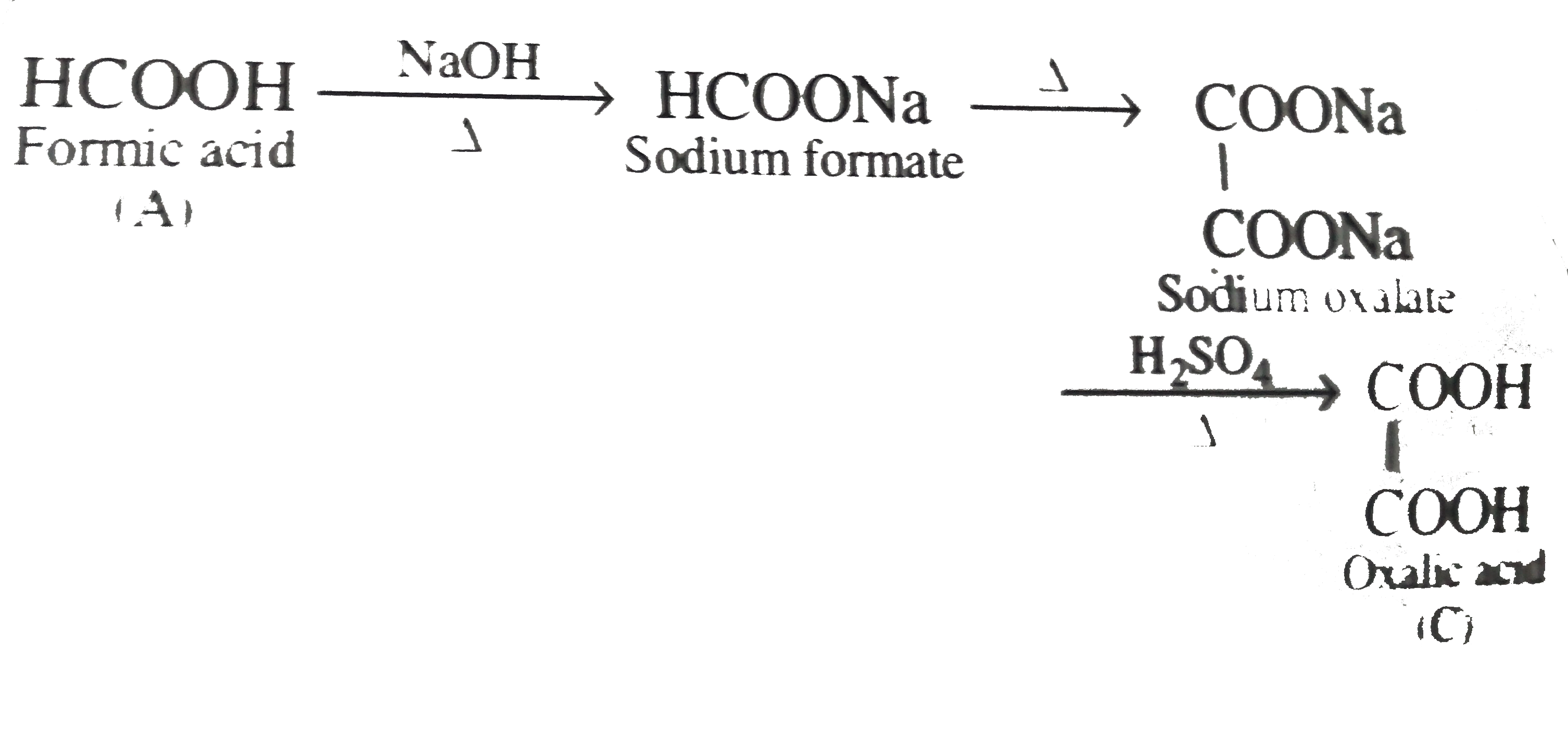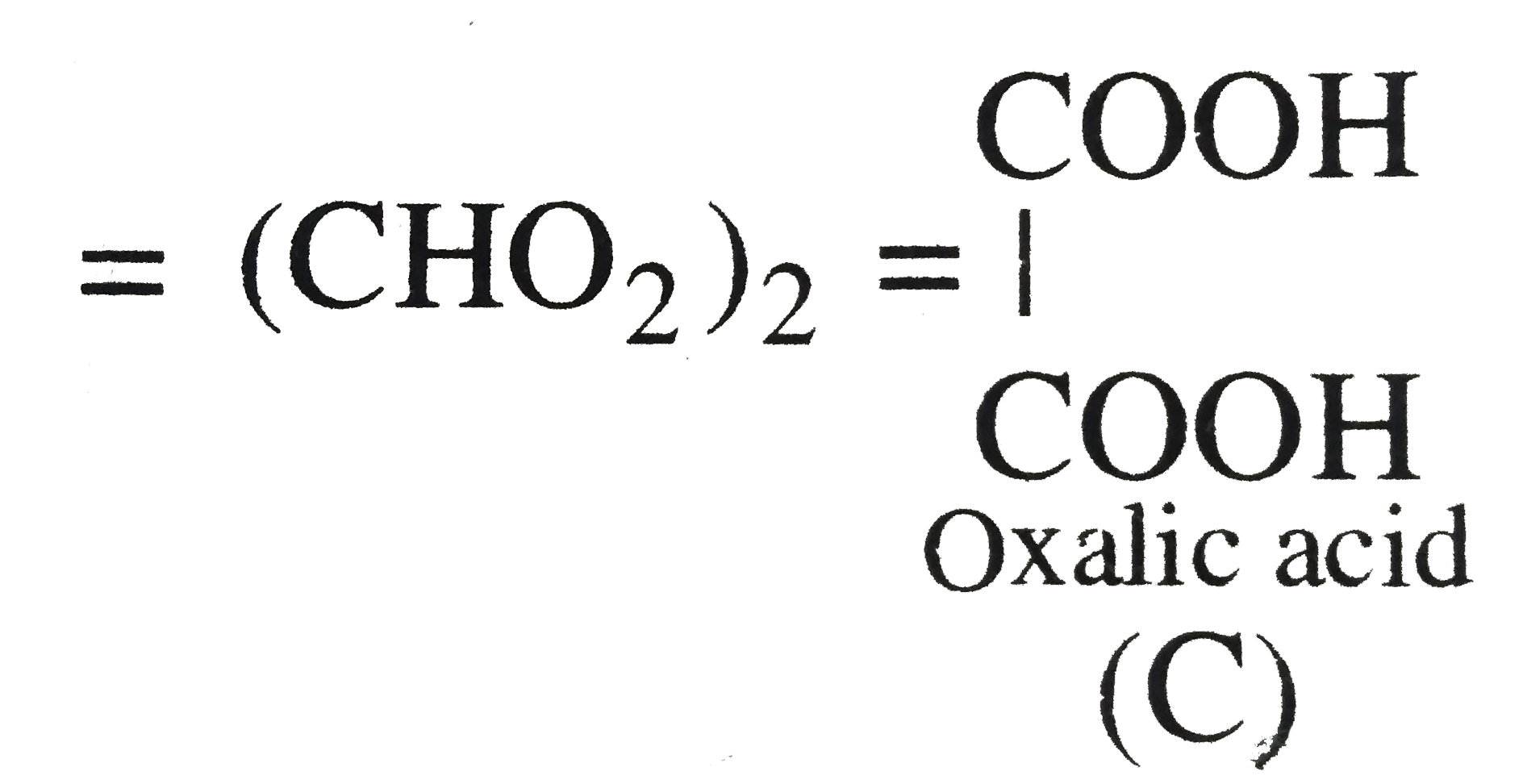The sodium salt of a carboxylic acid, A, was produced by passing a gas, B, into an aqueous solution of caustic alkali at an elevated temperature and pressure. A on heating in presence of sodium hydroxide followed by treatment with sulphuric acid gave a dibasic acid C, A sameple of 0.4 g of C on combustion gave 0.08g of water and 0.39g of carbondioxide. The silver salt of acid weihin 1g on ignition yielded 0.71g of silver as residue. Identify A, B and C.
(i) Gas(B)+NaOHHigh.P,T−−−−−−→RCOONa
This is characteristic reaction of CO2 with NaOH to give sodium formate.
CO2(B)+NaOHHigh−−→P,THCOONaH2O−−→HCOOH(A)
(ii) (A) on heating in the presence of NaOH followed with H2SO4 gives a dibasic acid (C).
 .
.
(iii) The data given for (C) also confirms that it is oxalic acid.
∣∣
∣
∣
∣
∣
∣
∣
∣∣ElementPercentageRelative no of atomsSimplest ratio=Percentageat. massC1244×0.390.40×100=26.5926.5912=2.211H218×0.080.40×100=2.222.221=2.221O100−(26.59+2.22)=71.1971.1916=4.442∣∣
∣
∣
∣
∣
∣
∣
∣∣
∴ Empirical formula of (C) is CHO2.
Empirical wt.45
Also, Mw of (C) is
Wt.ofAgEwofAg=Wt. of Ag saltE+108
(where E is the Ew of anion of acid)
0.71108=1E+108
∴E=44 (i.e., Ew of anion of acid)
∴Ew of acid =44+1=45
Mw of acid =90
∴n=MwEmpirical formula wt.=9045=2
Molecule formula, =(Empirical formula)n

Topper's Solved these Questions
- BOOK - CENGAGE CHEMISTRY ENGLISHCHAPTER - CARBOXYLIC ACIDS AND THEIR DERIVATIVESEXERCISE - Exercises Archives (True/False)2videos
CARBOXYLIC ACIDS AND THEIR DERIVATIVES
- BOOK - CENGAGE CHEMISTRY ENGLISHCHAPTER - BIOMOLECULESEXERCISE - Exercises Archives (Analytical And Descriptive)8videos
BIOMOLECULES
- BOOK - CENGAGE CHEMISTRY ENGLISHCHAPTER - CHEMICAL KINETICSEXERCISE - Archives Subjective23videos
CHEMICAL KINETICS
Similar Questions
The sodium salt of a carboxylic acid (A) was produced by passing a gas (B) into an aqueous solution of caustic alkali at an envolved temperature and pressure (A) on heating in the presence of sodium hydroxide followed by the treatment with sulphuric acid gave a dibasic acid (C). A sample of 0.4gm of acid (C) on combustion gave 0.08gm of water,.39gm of CO2 and weighting 1.0gm on ignition yielded 0.71gm of silver as residue. Identify (A),(B), and (C).
View Solution0.76 g of a silver salt of a dibasic acid on ignition gave 0.54 g of silver. Calculate the molecular mass of the acid.
View Solution
Knowledge Check
- Question 1 - Select One
When sodium chloride is heated with concentrated sulphuric acid, the gas liberated is
AChlorineBSulphur dioxideCHydrogen chlorideDSulphur trioxide - Question 2 - Select One
0.759 g of a silver salt of a dibasic organic acid on ignition gave 0.463 g of silver. The molecular mass of the acid is
A70B140C108D216
0.20 g of an anhydrous dibasic acid gave on combustion 0.040 g water and 0.195 g CO2.0.5 g of its silver salt on ignition gave 0.355 g of silver. What is the molecular formula of the acid ?
View Solution0.76 g of a silver salt of a dibasic acid on ignition gave 0.54 g of silver. Calculate the molecular mass of the acid.
View SolutionWhat happens when the silver salt of a carboxylic acid is ignited ?
View Solution0.759 g of silver salt of a dibasic acid was ignited to form 0.463 g of the silver residue. Calculate the molecular mass of the acid.
View SolutionSodium thiosulfate is a salt of which acid ?
View SolutionAqueous solution of orthoboric acid can be titrated against sodium hydroxide using phenolphthalein indicator only in presence of
View Solution

